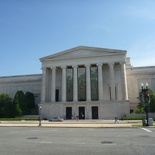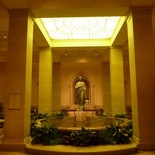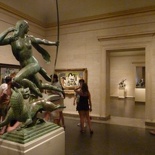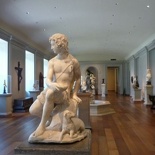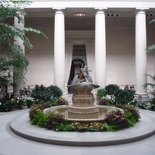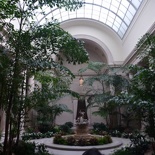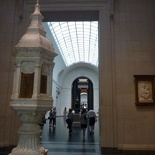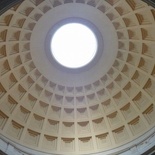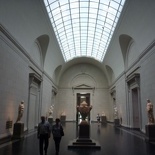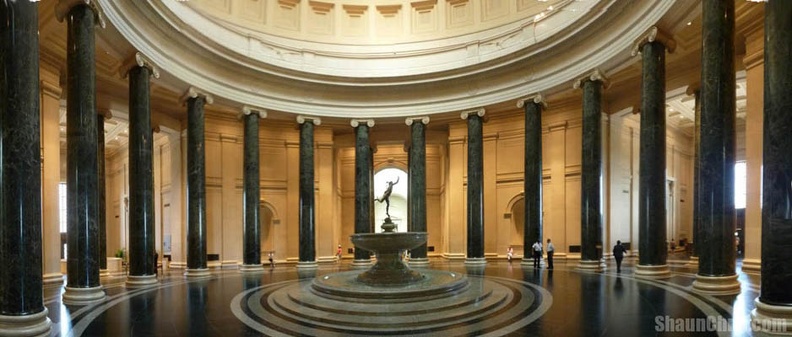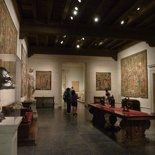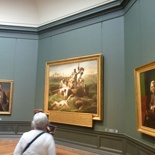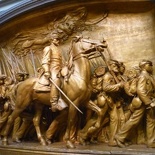The National Gallery of Art is a national art museum, located on the National Mall in Washington, D.C. The gallery itself can be accessed via the north entrance from Constitution Ave & 6th Street in addition to the National mall south entrance. It’s one of the main museums along the National mall with it’s neoclassical front architecture. The museum saw itself with humble beginnings displaying a substantial art collection as donated by Andrew W. Mellon. The building itself, established in 1937 was built using funds from the United States Congress for the people of the United States of America. The museum is open daily 10am to 6pm and till 9pm on Fridays. Entry is free of charge to the public.
There is both a north and south entrance, with the latter from the National Mall. Both entrances situated at the center of the museum will bring you to the lower level atrium, which is an open mini fountain and gathering area just below the main museum rotunda, which resides just one floor above. You can use the cloak rooms here to store your bulky bags and hand carry items as they are not recommended to be brought around the galleries in fear of accidental damage to the exhibits. You are allowed to hand carry these bags into the galleries. The museum itself is split into an eastern and western wing, both identical to each other in terms of floor plan and spans two floors housing mainly collections of paintings, drawings and prints.
There were few photographic works too, which makes up the minority of the displayed work, as they are not much of “traditional art” which makes up the bulk of the displays here. Much of the American art here dates as early as the 17th century, with the core collection featuring major works of art donated by iconic business people such as Lessing J. Rosenwald (president of Sears), Paul Mellon, Ailsa Mellon Bruce and Samuel Henry Kress just to name afew. There were few sculptures on display, which makes up most of the exhibits on the sculpture halls, linking the main halls to the various smaller galleries in the museum. Going on with the donation frenzy, the magic about such museums is that most of the items on displays are contributed mostly by the people themselves for the people. Who knows what other hidden treasures of historical significance can the average household be having in their homes these days, waiting to be discovered for the museum. Few other notable artwork donors also includes Rush Harrison Kress, Peter Arrell Brown Widener, Joseph E. Widener and Chester Dale.
Flaunting the ends of the sculpture halls are the garden courts, which are large man-made gardens complete with a flowing fountain and skylight ceiling to boot. The location provides an outdoor setting for exhibiting a number of pieces from the Museum’s contemporary sculpture collection. These gardens are like little oases and a break from all the wooden decked galleries which line every single gallery here. The stairwells at the end of the gardens will take you to staircases serving both museum floors, offering views of the museum’s outdoor Art Sculpture Garden. Joining both halls is the museum’s grand rotunda- modeled after the interior of the Pantheon in Rome, decked with a white oculus with a distinct pink hue of Tennessee marble which sits right at the center of the museum.
The lower galleries are smaller in comparison to the upper floored ones, housing most early Victorian furniture, fireplaces and olden day home settings. Also on display here too is the sculpture gallery featuring mostly marble statues, with the highlights being the 46 wax statuettes by Degas to Honoré Daumier’s entire series of bronze sculptures, including all 36 of his caricatured portrait busts of French government officials. There are glass cabinet displays featuring a range of Chinese porcelain, as well as renaissance decorative arts.
The upper floors houses mostly decorative works, including medals, and decorative arts. These works traces the development of Western Art from the Middle Ages to the present, including the only painting by Leonardo da Vinci in the Americas. The feature then at my visit was The Shaw Memorial Project, with artworks paying tribute to the American officer in the Union Army who fought during the American Civil War. Moreover, the West Building spots an extensive collection of paintings and sculptures by European masters from the medieval period through the late 19th century, as well as pre-20th century works by American artists.
Personally, the museum is a fine place to hang out, but there is not quite many displays here to see to begin with. It is after all a small cozy museum, and you will be done with both floors within 2-3 hours or so, leaving you time to explore the many other museums along the National Mall.
- New York City & Brooklyn (Photos: New York City & Brooklyn)
- New York Hudson River Cruise, Wall street and Rockefeller Center
- American Museum of Natural History (New York) (Photos: AMNH)
- Washington D.C. (Photos: Washington D.C.)
- Newseum, Washington DC (Photos: The Newseum)
- National Gallery of Art, Washington (Photos: National Gallery of Art)
- Arlington National Cemetery, Washington DC (Photos: Arlington National Cemetery)
- Smithsonian Natural History Museum (Photos: NMNH)
- Smithsonian Air and Space Museum (Photos: Air & Space Museum)
- Orlando, Florida & Magic Kingdom at Walt Disney World Resort (Photos: Disney Magic Kingdom)
- Orlando Disneyland Hollywood (MGM) Studios (Photos: Disneyland Hollywood Studios)
- NASA- Kennedy Space Center, Merritt Island, Cape Canaveral (Photos: Kennedy Space Center)
- Islands of Adventure, Orlando Florida (Photos: Islands of Adventure)
- Universal Studios Orlando, Florida (Photos: Universal Studios Orlando)
- Miami Florida, South Beach and Aventura mall (Photos: Miami Florida)
- Pittsburgh, Pennsylvania (Photos: Pittsburgh, Pennsylvania)
- Cedar Point coaster kingdom, Sandusky Ohio (Photos: Cedar Point)

